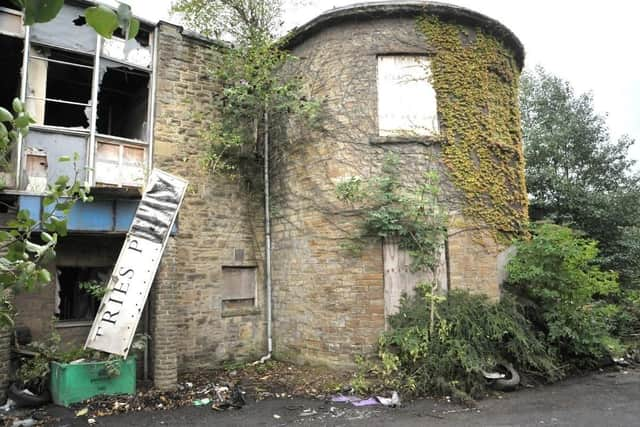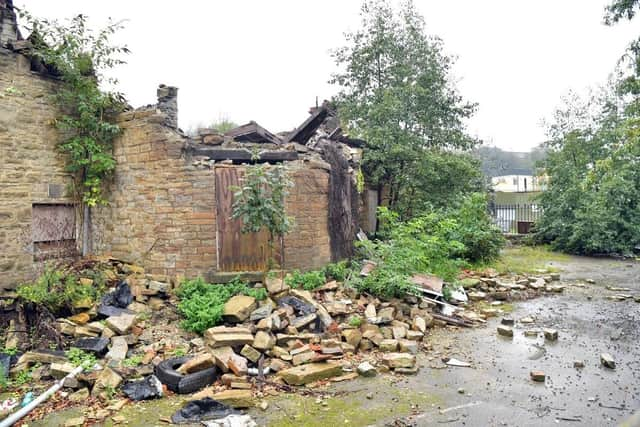Investigation into loss of Grade II-listed 1830s building in Yorkshire after it collapses due to 'stone theft' - despite owners applying twice to demolish it
The owners of the Grade II listed Tank and Drums building on Bowling Back Lane say the structure collapsed due to damage from a large fire over two years ago, and repeatedly being targeted by stone thieves since.
Bradford Council says it is continuing investigations into the loss of the building.
Advertisement
Hide AdAdvertisement
Hide AdThe building was once known as Bowling House, and formed part of the wider Bowling Iron Works site.


It was built as an impressive villa, before becoming the boardroom and offices for the Tank and Drums company in the early 1970s.
At one point the company employed over 350 people in Bradford, but Tank and Drums closed in 1999.
In the past two years the current owners Leo Sawrij Ltd, which purchased the site in 2019, have submitted two applications to Bradford Council for permission to demolish the listed building.
But both applications were refused.


Advertisement
Hide AdAdvertisement
Hide AdThe company had said the deteriorating state of the building meant it had become a “health and safety risk.”
There had been no proposals to build anything on the site in its place.
But responding the two applications, Conservation officers at the Council said “In considering the total loss of significance of a heritage asset it must be borne in mind that such a decision is irreversible and must be in absolute last resort.
“It has not been demonstrated that other options for the retention and repair of this statutorily protected building have been considered, explored or costed.”
Advertisement
Hide AdAdvertisement
Hide AdThe two applications had also received objections from Historic England, the Council for British Archaeology, the Georgian Group and Historic Buildings & Places.
The Local Democracy Reporting Service noticed that the building was no longer standing late last month.
When asked for a response to the loss of the listed building, a spokesman for Leo Sawrij Ltd said: “The listed building has collapsed.
“The structure was badly damaged by a fire on 23 February 2021 and since then has been subjected to persistent stone, metal and slate theft which have contributed to further degradation of the building despite our attempts to secure the site.
Advertisement
Hide AdAdvertisement
Hide Ad“As recently as April this year, we commissioned a team of experts, consisting of a structural engineer with recognised historic building qualifications and an experienced historic buildings architect, to examine future options for the listed building. We were also in close contact with the Council’s Conservation Officer.
“When our team of experts last visited the site at the end of June, they found that parts of the building had collapsed. This was immediately reported to the Conservation Officer, who then visited the site himself to assess the situation.
“We are currently waiting for feedback from the Council on how to proceed.”
A Bradford Council spokesman said: “We are continuing investigations on the site. The information will then be assessed, and the matter will be reviewed regarding the action to be taken.”
Advertisement
Hide AdAdvertisement
Hide AdA Historic England spokesperson said: “We are sorry to see the loss of this Grade II listed building.
“We advised that despite its poor condition, a viable solution might be possible once repairs were made. We objected to its proposed demolition in 2021 and 2022.”
An extension was built to the listed building in the 1970s. Last month Leo Sawrij Limited submitted an application to demolish this more modern extension.
However, that application has this week been refused by planning officers, who pointed out that as the extension was present when the building was listed in 1983, it is also classed as a listed building.
Advertisement
Hide AdAdvertisement
Hide AdA report by officers said: “Site photos demonstrate that demolition works have already been carried out, although not clear when the demolition occurred, which has led to the destruction of the main stone villa/property of which the office building/extension joined, resulting in the irreversible loss of the majority of this heritage asset.
“As the former office building was fixed to the building and present at the time of the listing, the modern section of the building for which permission has been sought to demolish, is also Grade II listed.
“Listed Building Consent is therefore required to undertake any works to any part of the building.